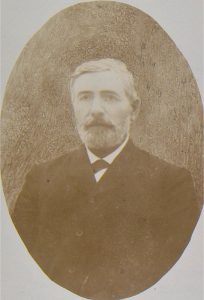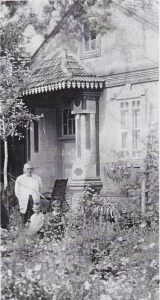Sigmund Kemmler, born May 9, 1798 in Wankheim emigrated in 1817 via Reicheneck to Bessarabia. His parents had moved from Wankheim to Reicheneck. In Arzis in Bessarabia he married Anna Katharina Kraemer from Oferdingen.
Dr. Walter Schmid wrote in his book „Die Auswanderung von den Härten“ (The emigration from the Haerten“ on the pages 62 – 65:

Grandson of the emigrant Sigmund Kemmler
The question whether one should stay in the homeland or emigrate to Kaukasia was also a topic during the private religious sessions in Wankheim. There some man from Lustnau, who already decided to leave the country where leading the ceremony and were analyzing the bible, although the local pastor was angry about it. Based on their influence and the calculation of the final countdown and the prophesies of the end of the world, the 19 year old Sigmund Kemmler emigrated via Reicheneck to Russia. Reliable information is not provided by an immigration list from Teplitz[1]., issued March 1818. On that list is Sigmund Kemmler and Katharina Kemmler, born Krämer from „Offerdingen“. They joined up with other emigrants from Kirchentellinsfurt and Dettenhausen the Walddorfer Emigrations-„Harmonie“ (harmony here is more a club). This club was founded by religiously like-minded people with the purpose of emigration and joined settlement in the new world. Alone 19 families and one single from Walddorf were part of this club.
Johannes Maier from Walddorf und Philip Rohrer from Grafenberg were elected to the Elder Statesman of the little community. They were responsible for the religious and adminstration tasks, like the service, the education of the kids and the protection of the poor or ill people. All members of the Walddorfer „Harmony“ met on Jun 5, 1817 with their horses and coaches for the departure to Ulm. From there they took the ship called “Ulmer Box” on the Danube river. The trip war cumbersome and dangerous. After the arrival at the border station in Ismail at the beginning of the Danube delta a fever epidemic, so that during the 24 days of quarantine already a big part of the emigrants died. Although details are not transmitted, it is sure that Sigmund Kemmler and Katharina Kraemer survived the epidemic, but immediately after with other 18 families from the Tuebingen county separated from the main treck.Together with about 100 other families they have settled 90 Werst (60 miles) northeast of Ismail in a steppe valley and founded the colony Teplitz.
They are named in the first immigration list from March 1st, 1818, further there are families listed from Walddorf, Ruebgarten, Pliezhausen, Dettingen/Erms, Oferdingen and Reutlingen.

How difficult the beginning in Teplitz was, can be assumed from the following report:
„Each family did get upon arrival 100 Rubel silver in cash. The first task was to build temporary houses. After the 24 days of quarantine in Ismail most of the people felt ill of dysentery of fever in the settlement. In a lot of huts there was no one who could hand another person a glass of water. So the Major was forced to review all houses to identify who died and who was still living. On some days 6-7 bodies had to be buried and the death ration increased in a way that after 4 months already 110 people died. In the first time there was a lot of poverty[2]“.
About the further destiny of Sigmund there is little information. According an entry in the immigration list he died 4 years after his arrival in Teplitz. The family name showed up in later years again. A Simon Kemmler was elected to a court jury member in Teplitz from 1851 – 54 and from 1858 – 60 he was elected as Mayor.
Contact to the descendants

At this point I can bring some light in the history. In 2002 I could make a first contact to the descendants of Sigmund Kemmler. In May 2003 I met Lucie Kasischke-Kämmler, the grand-grand-grand-daughter of Sigmund Kemmler and she told me some stories from her family.
She, herself was still born in Teplitz, Bessarabia and had a relaxed youth there. Interestingly the people there kept their tradition and still spoke the Swabian dialect. In 1940 the luck of the family changed when the agreement between the Russian president and the German Hitler was signed that all people with a German heritage will be relocated and had to leave their homes and everything behind.

1945 the destiny hit them again. The escape of the Russian army failed and she was displaced to Siberia together with her brother and her mother. The grandparents had died during the escape. In Siberia finally her mother died. It was in 1955 when she and her brother Felix were allowed to return to Germany, where their father was waiting for them for 10 years already. Lucie wrote a book „Im Schneesturm – Ein deutsches Mädchen verschleppt nach Karagand“ (In the snow storm – a German girl displaced to Karagand) about her early life. The book was previously available on Amazon.com but has been skipped in the meantime.
I was deeply impressed of her destiny but also from her unbelievable energy. Thanks to her kindness she also gave me some photographs of her family. In addition she provided me with a lot of information about the descendants of Sigmund Kemmler. I’m therefore in the position to provide an ancestry chart if requested.

Back to Sigmund Kemmler. Shortly before his death in June 1822 his son, Sigmund, was born. With his birth the typing of the name changed to Kaemmler. Sigmund junior did get 3 other illegitimate siblings, which were also carrying the name Kaemmler. His descendants did perform well and were holding important positions in the community.
Today a lot of Sigmund Kemmler’s descendants live in Baden-Württemberg.
[1] Weiß;H.; Geschichte der Kolonie Teplitz, Tarutino 1931, S. 24
[2] Leibbrandt, G.; Die Auswanderung aus Schwaben nach Rußland 1816 – 1823, Stuttgart 1928, S. 139
